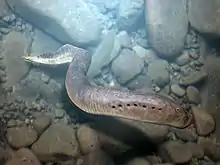Mesomyzon
Mesomyzon mengae is an extinct lamprey from freshwater strata of the Early Cretaceous-aged Yixian Formation, in China. So far, M. mengae is the only lamprey known from post-Paleozoic fossils.[1]
| Mesomyzon Temporal range: Early Cretaceous | |
|---|---|
 | |
| Fossil specimen of M. mengae | |
 | |
| Life reconstruction of Mesomyzon mengae | |
| Scientific classification | |
| Kingdom: | |
| Phylum: | |
| Class: | |
| Order: | |
| Genus: | Mesomyzon Chang, Zhang & Miao 2006 |
| Type species | |
| Mesomyzon mengae Chang, Zhang & Miao 2006 | |
The animal's exquisitely preserved fossils show a creature very similar to modern-day lampreys, having a well-developed sucking oral disk, a branchial basket, at least seven pairs of gill pouches and corresponding gill arches, impressions of gill filaments, and at least 80 myomeres of its musculature.[1]
A phylogenetic analysis conducted in 2018 shows that Mesomyzon is the fossil lamprey most closely related to modern taxa, though it is not closely related to any modern group.[2] On the other hand, Brownstein & Near (2022) found it to be a member of the lamprey crown group, most closely related to northern lampreys.[3]
References
- Chang, M. M.; Zhang, J.; Miao, D. (2006). "A lamprey from the Cretaceous Jehol biota of China". Nature. 441 (7096): 972–974. Bibcode:2006Natur.441..972C. doi:10.1038/nature04730. PMID 16791193. S2CID 4427676.
- Miyashita, Tetsuto; Coates, Michael I.; Farrar, Robert; Larson, Peter; Manning, Phillip L.; Wogelius, Roy A.; Edwards, Nicholas P.; Anné, Jennifer; Bergmann, Uwe; Palmer, A. Richard; Currie, Philip J. (2019-02-05). "Hagfish from the Cretaceous Tethys Sea and a reconciliation of the morphological–molecular conflict in early vertebrate phylogeny". Proceedings of the National Academy of Sciences. 116 (6): 2146–2151. Bibcode:2019PNAS..116.2146M. doi:10.1073/pnas.1814794116. ISSN 0027-8424. PMC 6369785. PMID 30670644.
- Brownstein, C. D.; Near, T. J. (2022). "Phylogenetics and the Cenozoic radiation of lampreys". Current Biology. 33 (2): 397–404.e3. doi:10.1016/j.cub.2022.12.018. PMID 36586410. S2CID 255278945.